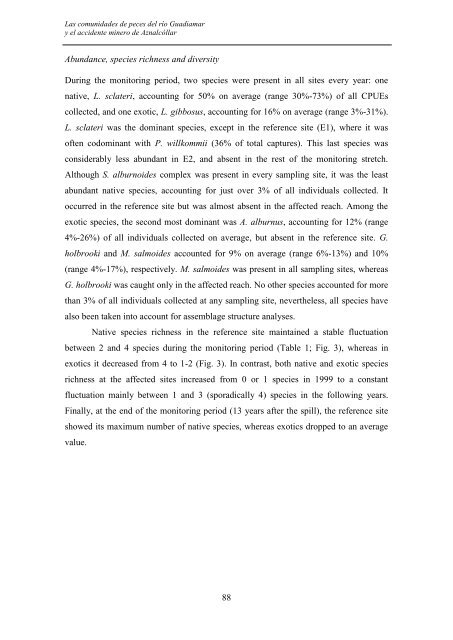las comunidades de peces del río guadiamar y el accidente minero ...
las comunidades de peces del río guadiamar y el accidente minero ...
las comunidades de peces del río guadiamar y el accidente minero ...
You also want an ePaper? Increase the reach of your titles
YUMPU automatically turns print PDFs into web optimized ePapers that Google loves.
Las <strong>comunida<strong>de</strong>s</strong> <strong>de</strong> <strong>peces</strong> <strong>de</strong>l <strong>río</strong> Guadiamar<br />
y <strong>el</strong> acci<strong>de</strong>nte <strong>minero</strong> <strong>de</strong> Aznalcóllar<br />
Abundance, species richness and diversity<br />
During the monitoring period, two species were present in all sites every year: one<br />
native, L. sclateri, accounting for 50% on average (range 30%-73%) of all CPUEs<br />
collected, and one exotic, L. gibbosus, accounting for 16% on average (range 3%-31%).<br />
L. sclateri was the dominant species, except in the reference site (E1), where it was<br />
often codominant with P. willkommii (36% of total captures). This <strong>las</strong>t species was<br />
consi<strong>de</strong>rably less abundant in E2, and absent in the rest of the monitoring stretch.<br />
Although S. alburnoi<strong>de</strong>s complex was present in every sampling site, it was the least<br />
abundant native species, accounting for just over 3% of all individuals collected. It<br />
occurred in the reference site but was almost absent in the affected reach. Among the<br />
exotic species, the second most dominant was A. alburnus, accounting for 12% (range<br />
4%-26%) of all individuals collected on average, but absent in the reference site. G.<br />
holbrooki and M. salmoi<strong>de</strong>s accounted for 9% on average (range 6%-13%) and 10%<br />
(range 4%-17%), respectiv<strong>el</strong>y. M. salmoi<strong>de</strong>s was present in all sampling sites, whereas<br />
G. holbrooki was caught only in the affected reach. No other species accounted for more<br />
than 3% of all individuals collected at any sampling site, neverth<strong>el</strong>ess, all species have<br />
also been taken into account for assemblage structure analyses.<br />
Native species richness in the reference site maintained a stable fluctuation<br />
between 2 and 4 species during the monitoring period (Table 1; Fig. 3), whereas in<br />
exotics it <strong>de</strong>creased from 4 to 1-2 (Fig. 3). In contrast, both native and exotic species<br />
richness at the affected sites increased from 0 or 1 species in 1999 to a constant<br />
fluctuation mainly between 1 and 3 (sporadically 4) species in the following years.<br />
Finally, at the end of the monitoring period (13 years after the spill), the reference site<br />
showed its maximum number of native species, whereas exotics dropped to an average<br />
value.<br />
88

















